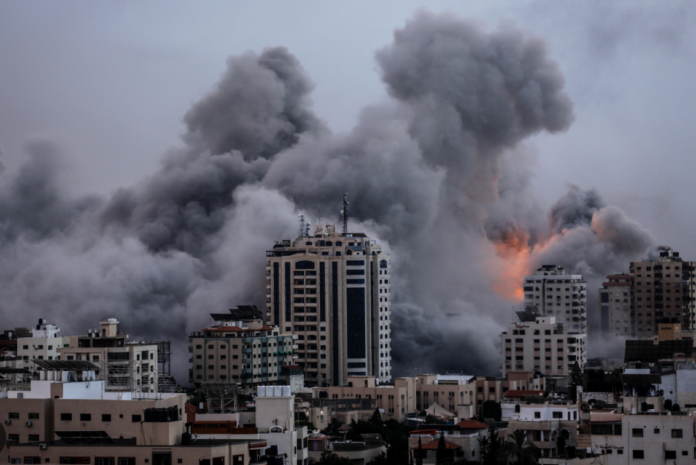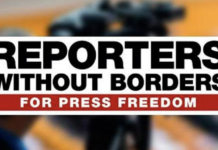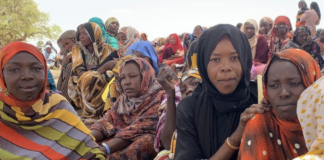GAZA/JERUSALEM, Jan 14 (Xinhua) — Tens of thousands of families in both Israel and Palestine are still grieving the loss of their loved ones on Sunday, 100 days after Hamas’s unexpected attack on southern Israel triggered a massive Israeli military campaign in the Gaza Strip.
Despite the repeated calls from the international community for an end to the ongoing violence and a return to peace, the Israel-Hamas conflict, which has shaken the Middle East’s geopolitical landscape, shows no signs of abating anytime soon.
Israeli troops conduct military operations in Gaza Strip, on Jan. 11, 2024.
More than three months into the conflict, Israel withdrew some of its troops from the Gaza Strip in response to U.S. demands to scale back large-scale ground and aerial operations and protect civilians in the Palestinian enclave.
On Jan. 7, Israeli Defense Minister Yoav Gallant told the Wall Street Journal that the Israeli army will soon switch from the “intense maneuvering phase of the war” to “different types of special operations” in northern Gaza.
Israel’s ground operations and bombardment, while less intense than before, are still going on, with a focus on the southern region of the Gaza Strip, where a large part of the population is stranded after being displaced from the north and elsewhere.
The number of injured Palestinians has so far surpassed 60,000 and the Palestinian death toll in the enclave, already over 23,700, is on the rise, according to figures released by the Gaza-based Health Ministry.
Under U.S. pressure, the Israeli army is seeking to gradually reduce the intensity of military operations in the Gaza Strip in 2024, but the duration of the conflict may be lengthened, said Jerusalem-based Palestinian political analyst Firas Yaghi.
During a visit to the West Bank on Jan. 7, Herzi Halevi, chief of staff of the Israel Defense Forces (IDF), said the conflict in Gaza would likely last throughout 2024.
He also warned of a possible flare-up in violence “on other fronts, especially the West Bank,” and said the IDF would increase “the pressure it exerts” on Israel’s northern border with Lebanon, where it has traded fire with Hezbollah, a Shiite military group, in recent months.
Children are seen in front of a damaged building in Jabalia refugee camp in the northern Gaza Strip, on Jan. 9, 2024.
As the humanitarian crisis in the Gaza Strip worsens, Israel is coming under increasing pressure both internationally and domestically.
As entire neighborhoods in the Gaza Strip have been leveled by the Israeli bombardments, about 1.9 million of Gaza’s 2.3 million people are displaced, according to statistics released by the UN Office for the Coordination of Humanitarian Affairs.
On Dec. 22, the UN Security Council passed a key resolution aimed at boosting the flow of humanitarian supplies into Gaza after a week of negotiations and substantial amendments. It followed a resolution adopted on Dec. 12 by the UN General Assembly demanding an “immediate humanitarian ceasefire” in Gaza.
As for the United States, with the 2024 presidential election expected to be a tight race, the administration under President Joe Biden is expected to put more pressure on Israel to win voters who are unhappy about the U.S. stance on the Gaza conflict, said Yaghi.
In Israel, many people believe that Prime Minister Benjamin Netanyahu’s efforts to push for judicial reform have caused chaos in the country and given Hamas an opportunity to attack and that the way the government and military handled issues such as rescuing hostages is not satisfactory.
Despite prolonged Israeli air strikes and ground operations, 132 of the 253 hostages that Hamas and other Palestinian militant groups kidnapped on Oct. 7 are still being held in the Gaza Strip. Meanwhile, Palestinian militants are still capable of firing rockets into Israel.
In the face of the international community’s pressure and criticism, Israel is looking for alternative plans to achieve its goals by fighting in specific areas of the Gaza Strip, said Yaghi.
Since the beginning of this year, tensions in the Middle East have escalated as a result of the spillover of the Israel-Hamas conflict.
On Jan. 2, an Israeli drone strike on Beirut’s southern suburbs of Dahiyeh, a Hezbollah stronghold, killed Saleh al-Arouri, deputy chairman of Hamas’s political bureau, alongside six other members of the Palestinian militant group.
After the strike, Hezbollah Secretary-General Hassan Nasrallah warned the next day that the Iran-backed group “cannot be silent.” He denounced the attack as “a dangerous crime,” vowing revenge and threatening to meet any wider Israeli operation with unrestrained warfare.
Eyal Pinko, an intelligence and national security expert at the Begin-Sadat Center for Strategic Studies in Israel, said Israel’s strikes on senior Hamas leader inside Lebanon cannot pass in silence. “Hezbollah will revenge one way or another, they must, they have to, and it won’t be another way,” he said.
Meanwhile, local militia in Iraq escalated attacks on U.S. military bases in Iraq and Syria, triggering a retaliatory U.S. strike in Baghdad on Jan. 4 that killed a leader of the Harakat al-Nujaba group operating in both Iraq and Syria.
Another worrying development happens in the Red Sea. The Houthi military group, which has been fighting a civil war with Yemen’s government forces, launched drone and rocket attacks in the Red Sea on cargo ships that have links to Israel to retaliate Israeli attacks on Gaza.
The Houthi attacks prompted the United States and Britain to stage air strikes on the targets of the military group on Thursday and Saturday. The Houthi leadership vowed to launch retaliatory attacks soon.



















